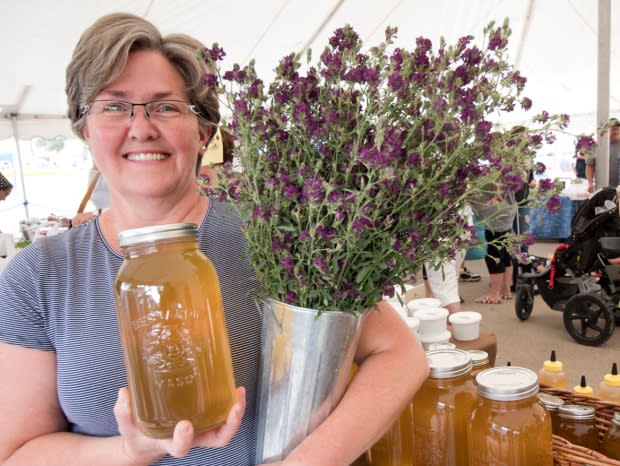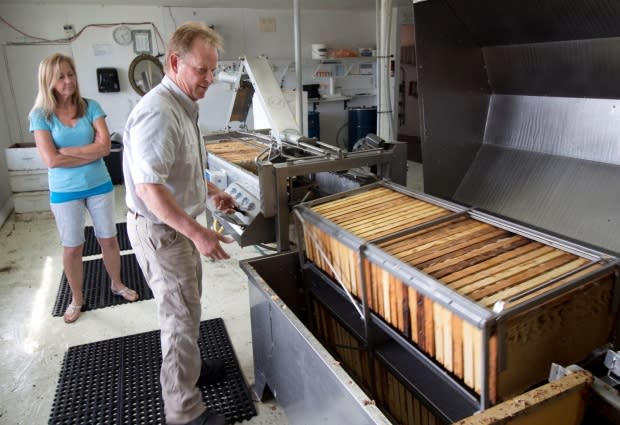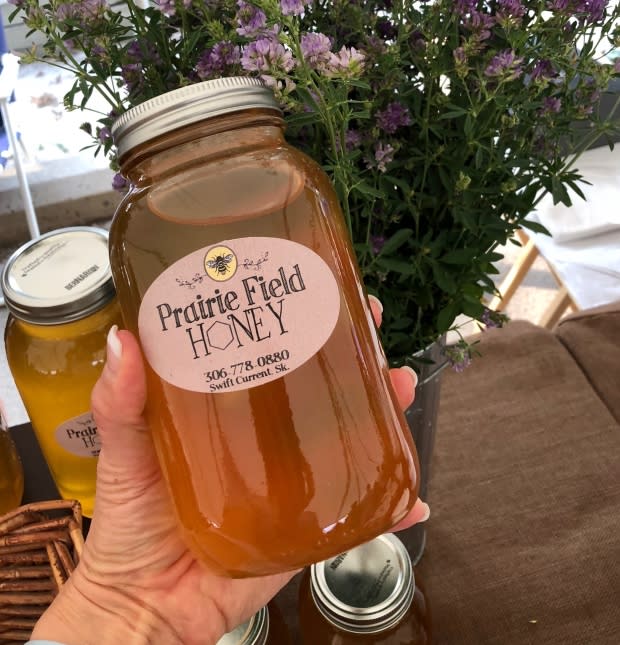It's good to 'bee' here: Saskatchewan's honey business thriving
When it comes to honey, Saskatchewan produces some sweet statistics.
As of 2016, the province is home to 112,000 colonies – second in Canada only to Alberta. Saskatchewan contributes 25 per cent of Canada's honey production.
The reasons people get into beekeeping are as varied as the plants the bees pollinate. Some are branching out into value-added products, selling propolis, beeswax candles and flavoured honey. Saskatoon Three Foragers Bee Co. even has a line of honey caramels.
Here's a look at a few outstanding Saskatchewan people that help keep bees healthy and thriving while providing us all with honey direct from the source.
Good Eat'n Honey
Ian Eaton and his wife Verna run a booming honey business north of Saskatoon.
Eaton has between 650 and 700 hives. About 350 of those are producing colonies, while the rest are nucleus hives — starter colonies building in population for the next year.
The majority of their honey ends up with the large brand Bee Maid, but the couple keeps a portion of their sweet clover and wildflower honey to sell under their Good Eat'N Honey label in Saskatchewan.

In his decades as a beekeeper, Ian has become a keen bee observer. He says can interpret their dance – a bottom-wiggling jig bees use to alert the colony to nectar or pollen.
"I can actually watch a bee dance and I know where it's telling its girlfriends to go... I (will) see them dance and say, 'okay they're all going south.' And then I look, and sure enough, there's a field of something blooming (in the) south."

The Eatons' bees produce a lot of honey – anywhere between 114 to 160 kg per hive each year. Sometimes it comes in so fast it splashes out of the hives' frames. The bees work quickly to bring the moisture content down to around 18 per cent and preserve the honey.
"Sometimes we'll see thousands of bees out on the front of the hive fanning — trying to pull the air through to dehydrate that honey," said Ian.

Each bee produces about enough honey to fill an eyedropper, with 70 per cent of it being water. And yet, as a group, they bring in massive amounts.
"We're starting to think of the hive as one organism that all works together."
Maybe we could all take a lesson from the bees.
Kitako Lake Honey
Steve Hawrishok's farm, near Lac Vert, is in an idyllic spot close to fields, meadows and forests. It's fitting, since beekeeping is a calming, meditative career for him.

Hawrishok said the moments of quietness attract him to beekeeping.
"When you're looking at your bees, it can be very peaceful, very present, very relaxing. And then it ceases to become [work] and that can be a beautiful thing."
Hawrishok's dad began the beekeeping operation. Both of his parents still help out.

Hawrishok took over in 2013. Prior to that, he lived in Saskatoon and travelled abroad. He never imagined he would end up back on the farm.
"I was fairly resistant to the whole thing," he recalled.
"But something changed. I realized [I] was very lucky to have access to a place like this and that beekeeping is incredibly interesting. It's vital ecologically. There's a commercial market … and there's also a niche market for honey."

Prairie Field Honey
Prairie Field Honey is a family affair. Brenda and Kevin Epp run the business in Swift Current with their teenage sons Michael and Matthew.
They have partnerships with other farmers in the area. They trade honey or beeswax candles in exchange for permission to put hives in fields.

Brenda said the fields with their hives grow alfalfa so thick the farmer can barely cut it.
"The bees really do make a difference."
The Epps started out eight years ago with 100 hives. They were attracted by honey's health benefits. The boys were younger and the couple wanted to teach them the value of a hard day's work.

Now the business has grown to 200 hives and the Epps' sons are capable of running the operation alone.
"They have an appreciation of where their food comes from and what it takes to get that honey off the field," Brenda said.
"It's not an easy process. It's heavy and you've got to wear your suit. It's hot out there and you get stung. But I love it that we can do it as a family," said Brenda.
Barefoot Earth Farm
Perhaps the most surprising story comes from Viscount, where Rachel Lemke operates Barefoot Earth Farm. She keeps only 100 hives — small compared to commercial operations with 2,000. She said 100 is the perfect amount.
"(That way) I can focus on the health of every hive."

In 2017, her bees broke the provincial honey flow record. Those 100 hives each produced an astounding 233 kg.
According to bee scientist and breeder Albert Robertson, Saskatchewan has always had high amounts of honey production, thanks to the climate and agriculture here.

Long, hot summer days with plenty of canola blossoms mean honey bees can produce prolific honey flows.
"It's not uncommon for people to have [91 to 136 kg] crops per colony. Which is unheard of in a lot of other areas," he said.
Jenn Sharp is a freelance writer travelling the province this year in search of stories that connect us to the people growing and making our food.
If you're a baker, beekeeper, butcher, charcutier, cheesemaker, chocolatier, coffee roaster, craft brewer, distiller, farmer, farm-to-table chef, fishmonger, forager, market gardener, miller or orchardist in Saskatchewan, she wants to hear from you.
Her research will be compiled into the ultimate Saskatchewan food guide: Flat Out Delicious: Food Artisans of Saskatchewan. The book will be published by Touchwood Editions in spring 2020.

